-
 Bitcoin
Bitcoin $107,247.2038
-0.18% -
 Ethereum
Ethereum $2,424.7947
0.34% -
 Tether USDt
Tether USDt $1.0003
-0.02% -
 XRP
XRP $2.1171
-3.33% -
 BNB
BNB $645.6618
0.06% -
 Solana
Solana $141.5898
-1.32% -
 USDC
USDC $0.9998
0.00% -
 TRON
TRON $0.2710
-0.41% -
 Dogecoin
Dogecoin $0.1602
-2.99% -
 Cardano
Cardano $0.5553
-2.28% -
 Hyperliquid
Hyperliquid $36.3019
-2.42% -
 Bitcoin Cash
Bitcoin Cash $491.7212
2.04% -
 Chainlink
Chainlink $13.0810
-0.23% -
 Sui
Sui $2.6080
-5.06% -
 UNUS SED LEO
UNUS SED LEO $9.0040
-0.05% -
 Stellar
Stellar $0.2350
-3.06% -
 Avalanche
Avalanche $17.2294
-2.31% -
 Toncoin
Toncoin $2.8075
-1.05% -
 Shiba Inu
Shiba Inu $0.0...01121
-3.43% -
 Litecoin
Litecoin $84.2215
-0.32% -
 Hedera
Hedera $0.1429
-4.88% -
 Monero
Monero $312.2199
-0.90% -
 Dai
Dai $0.9997
-0.01% -
 Ethena USDe
Ethena USDe $0.9999
-0.02% -
 Polkadot
Polkadot $3.2973
-2.60% -
 Bitget Token
Bitget Token $4.4742
3.12% -
 Pi
Pi $0.5631
-10.10% -
 Uniswap
Uniswap $6.7817
-2.06% -
 Pepe
Pepe $0.0...09252
-3.74% -
 Aave
Aave $251.3830
-2.24%
Can I chase the long positive line that breaks through the 60-day line with large volume at the bottom?
A long positive candlestick breaking above the 60-day line with high volume may signal a bullish reversal in crypto, but confirmation and risk management are crucial to avoid false breakouts.
Jun 27, 2025 at 07:08 am
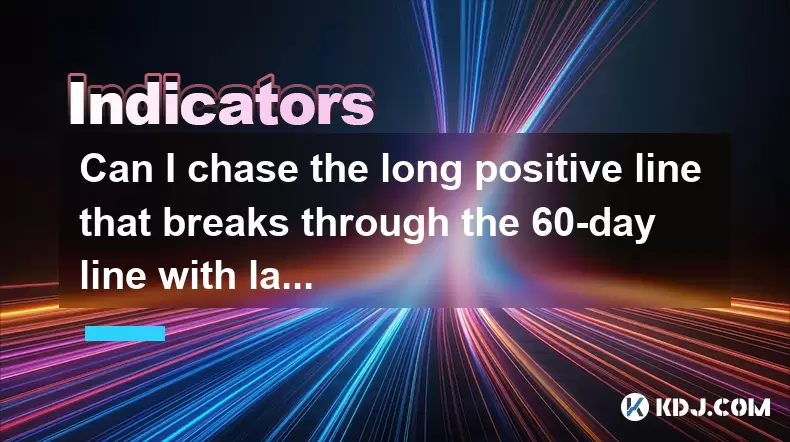
Understanding the 60-Day Line in Cryptocurrency Trading
In cryptocurrency trading, technical analysis plays a pivotal role in identifying potential entry and exit points. One of the commonly used tools is the 60-day moving average, often referred to as the 60-day line. This indicator smooths out price data over the last 60 days and helps traders determine the medium-term trend direction.
When a long positive candlestick breaks through this 60-day line with large volume at the bottom, it can signal a potential shift in market sentiment from bearish to bullish. However, not every breakout guarantees a successful trend continuation or reversal. It's essential to evaluate other factors before deciding whether to chase such a move.
Key Takeaway: The 60-day line acts as a critical support/resistance level in medium-term crypto trading strategies.
What Does a Long Positive Candlestick Indicate?
A long positive candlestick refers to a candle where the closing price is significantly higher than the opening price, with minimal upper or lower shadows. This suggests strong buying pressure and indicates that bulls are taking control after a downtrend.
When such a candle appears near the 60-day moving average and manages to break above it with high volume, it may imply a reversal formation. In crypto markets, which are highly volatile, these signals are more pronounced due to frequent emotional swings among traders.
However, chasing this pattern without confirmation can be risky. Always consider the broader context, including previous support/resistance levels, overall trend strength, and macroeconomic conditions affecting crypto assets.
Why Volume Matters in Breakout Scenarios
Volume is a crucial factor when assessing the validity of any technical breakout. A breakout from the 60-day line accompanied by above-average volume increases the probability that the move has real momentum behind it.
In cryptocurrency charts, large spikes in volume during a breakout candle suggest institutional or whale participation, which can lead to sustainable moves. Conversely, if the breakout occurs on low volume, it might be a false signal or a trap set by market makers to flush out retail traders.
To assess volume effectively:
- Compare the current volume bar with the average volume of the past 20–30 sessions.
- Look for a clear spike rather than a gradual increase.
- Use volume indicators like OBV (On-Balance Volume) or Volume Weighted Average Price (VWAP) to confirm strength.
Important: High volume during a breakout enhances the credibility of the move but doesn't guarantee future success.
How to Confirm a Valid Breakout Above the 60-Day Line
Before entering a trade based on a breakout above the 60-day line, several confirmation steps should be followed:
- Wait for a retest: After breaking above the 60-day line, the price may come back to test it as new support. If it holds, that confirms strength.
- Check multiple timeframes: Confirm the same signal on both daily and 4-hour charts to filter out noise.
- Use additional indicators: Combine with RSI, MACD, or Bollinger Bands to ensure alignment with the broader trend.
- Monitor price action: Look for engulfing patterns, bullish harami, or hammer candles near the 60-day line for added confluence.
Chasing an immediate entry without confirmation may expose you to fakeouts and whipsaws, especially in crypto markets known for their volatility.
Risks Involved in Chasing Breakouts
While breakout trading can yield substantial profits, it also comes with significant risks:
- False breakouts: Markets often trick traders into entering trades only to reverse shortly afterward.
- Liquidity gaps: In less liquid altcoins, large orders can manipulate price temporarily, creating misleading signals.
- Overleveraging: Entering aggressively on margin without proper risk management can lead to forced liquidation.
To mitigate these risks:
- Set tight stop-loss orders below the breakout candle’s low.
- Never risk more than 1%–2% of your portfolio on a single trade.
- Avoid trading immediately after news events unless you have a solid strategy for handling volatility.
Critical Tip: Discipline and patience are key—wait for confirmation before committing capital.
FAQ: Frequently Asked Questions
Q: Can I rely solely on the 60-day line for making trading decisions?
No, the 60-day line should be used in conjunction with other indicators and price action signals to increase accuracy and reduce false signals.
Q: What if the price breaks the 60-day line but quickly reverses downward?
This could indicate a failed breakout. Traders should avoid entering until the level is retested and confirmed as support.
Q: How do I know if the volume is "large enough" to justify entering a trade?
Compare the current volume bar to the average volume of the past 20–30 days. A spike significantly above that average is considered strong.
Q: Should I enter immediately after the breakout candle closes or wait for a pullback?
It's generally safer to wait for a pullback or retest to avoid chasing the price. This allows for better entry levels and tighter stop-loss placement.
Disclaimer:info@kdj.com
The information provided is not trading advice. kdj.com does not assume any responsibility for any investments made based on the information provided in this article. Cryptocurrencies are highly volatile and it is highly recommended that you invest with caution after thorough research!
If you believe that the content used on this website infringes your copyright, please contact us immediately (info@kdj.com) and we will delete it promptly.
- Dogecoin to $1? Analysts Weigh In on DOGE's Breakout Potential
- 2025-06-27 10:30:12
- Memecoins, Growth, and Analysts: Decoding the Latest Trends
- 2025-06-27 10:30:12
- Dogecoin, Meme Coins, and the Rise of Neo Pepe: What's Hot in Crypto?
- 2025-06-27 10:50:12
- Memetic Provenance, Crypto, and Undervalued Primitives: Why Culture Matters
- 2025-06-27 09:30:12
- MAGACOIN, Ethereum, and Dogecoin: Navigating the Crypto Landscape in 2025
- 2025-06-27 08:50:12
- Shiba Inu, Portfolio, and Cryptocurrency: Navigating the Meme Coin Mania in 2025
- 2025-06-27 08:30:12
Related knowledge

How lethal is the death cross of EXPMA12 and 50 lines?
Jun 27,2025 at 11:15am
Understanding the Death Cross in EXPMA IndicatorsThe death cross is a technical analysis pattern that signals a potential bearish trend reversal. In the context of the EXPMA (Exponential Moving Average), particularly when analyzing the crossover between the EXPMA12 and EXPMA50 lines, traders often interpret this as a strong sell signal. The death cross ...
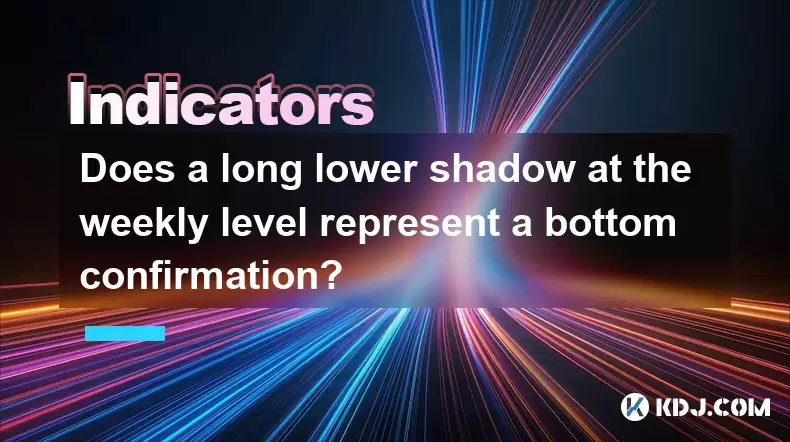
Does a long lower shadow at the weekly level represent a bottom confirmation?
Jun 27,2025 at 10:56am
Understanding the Weekly Lower Shadow in Candlestick AnalysisIn cryptocurrency trading, weekly candlestick patterns are often scrutinized for potential trend reversals. A long lower shadow at the weekly level indicates that during the week, sellers pushed prices down significantly but were met with strong buying pressure that closed the candle near its ...
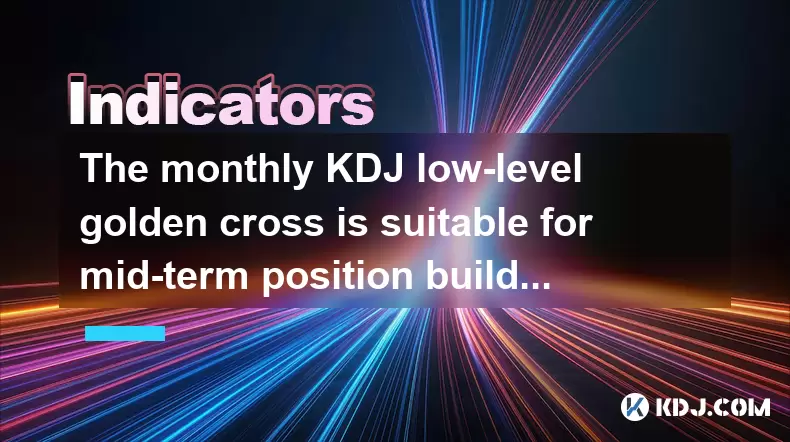
The monthly KDJ low-level golden cross is suitable for mid-term position building?
Jun 27,2025 at 03:14am
Understanding the Monthly KDJ IndicatorThe KDJ indicator, also known as the stochastic oscillator, is a momentum tool widely used in technical analysis within the cryptocurrency market. It consists of three lines: the K line, the D line, and the J line. These lines help traders identify overbought or oversold conditions, potential trend reversals, and e...
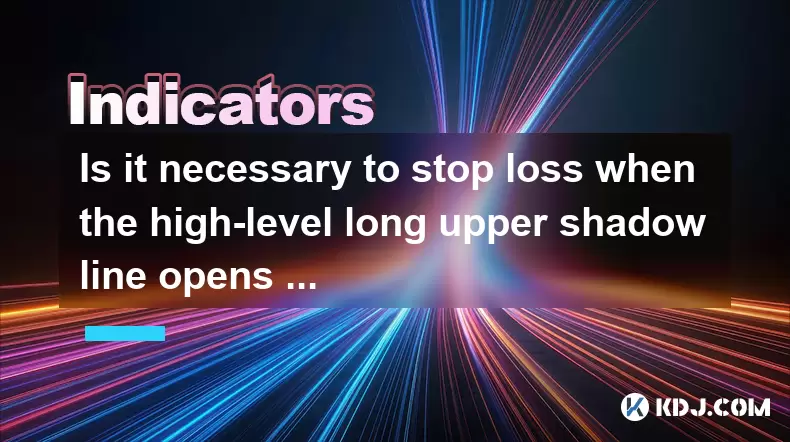
Is it necessary to stop loss when the high-level long upper shadow line opens low the next day?
Jun 27,2025 at 08:22am
Understanding the High-Level Long Upper Shadow LineIn technical analysis, a long upper shadow line refers to a candlestick pattern where the price moves significantly higher during the session but closes much lower, forming a long wick on the top. When this occurs at a high level, it suggests strong resistance and potential reversal. This type of candle...
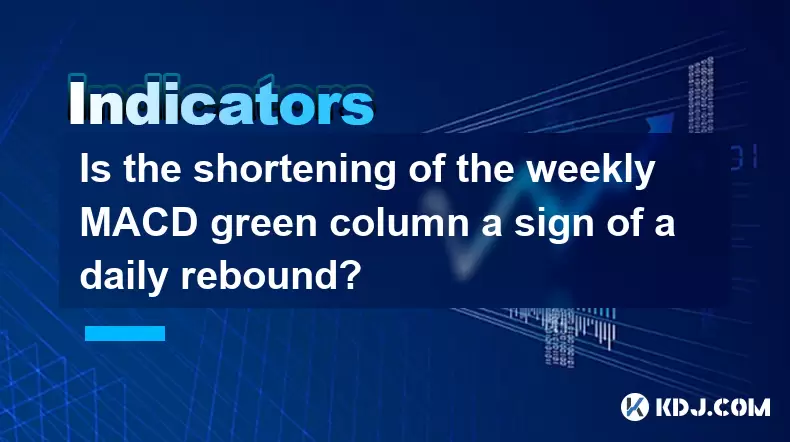
Is the shortening of the weekly MACD green column a sign of a daily rebound?
Jun 27,2025 at 10:22am
Understanding the Weekly MACD Green ColumnThe Moving Average Convergence Divergence (MACD) is a popular technical indicator used by traders to identify potential trend reversals and momentum shifts in financial markets, including cryptocurrencies. The green column in the MACD histogram represents the positive difference between the MACD line and the sig...

How sustainable is the rebound of the lower track of the Bollinger band?
Jun 27,2025 at 10:01am
Understanding the Bollinger Band and Its Lower TrackThe Bollinger Band is a widely used technical analysis tool in cryptocurrency trading, composed of a moving average (usually 20 periods) and two standard deviation lines plotted above and below it. The lower track, or lower Bollinger Band, represents a level that is typically two standard deviations be...

How lethal is the death cross of EXPMA12 and 50 lines?
Jun 27,2025 at 11:15am
Understanding the Death Cross in EXPMA IndicatorsThe death cross is a technical analysis pattern that signals a potential bearish trend reversal. In the context of the EXPMA (Exponential Moving Average), particularly when analyzing the crossover between the EXPMA12 and EXPMA50 lines, traders often interpret this as a strong sell signal. The death cross ...

Does a long lower shadow at the weekly level represent a bottom confirmation?
Jun 27,2025 at 10:56am
Understanding the Weekly Lower Shadow in Candlestick AnalysisIn cryptocurrency trading, weekly candlestick patterns are often scrutinized for potential trend reversals. A long lower shadow at the weekly level indicates that during the week, sellers pushed prices down significantly but were met with strong buying pressure that closed the candle near its ...

The monthly KDJ low-level golden cross is suitable for mid-term position building?
Jun 27,2025 at 03:14am
Understanding the Monthly KDJ IndicatorThe KDJ indicator, also known as the stochastic oscillator, is a momentum tool widely used in technical analysis within the cryptocurrency market. It consists of three lines: the K line, the D line, and the J line. These lines help traders identify overbought or oversold conditions, potential trend reversals, and e...

Is it necessary to stop loss when the high-level long upper shadow line opens low the next day?
Jun 27,2025 at 08:22am
Understanding the High-Level Long Upper Shadow LineIn technical analysis, a long upper shadow line refers to a candlestick pattern where the price moves significantly higher during the session but closes much lower, forming a long wick on the top. When this occurs at a high level, it suggests strong resistance and potential reversal. This type of candle...

Is the shortening of the weekly MACD green column a sign of a daily rebound?
Jun 27,2025 at 10:22am
Understanding the Weekly MACD Green ColumnThe Moving Average Convergence Divergence (MACD) is a popular technical indicator used by traders to identify potential trend reversals and momentum shifts in financial markets, including cryptocurrencies. The green column in the MACD histogram represents the positive difference between the MACD line and the sig...

How sustainable is the rebound of the lower track of the Bollinger band?
Jun 27,2025 at 10:01am
Understanding the Bollinger Band and Its Lower TrackThe Bollinger Band is a widely used technical analysis tool in cryptocurrency trading, composed of a moving average (usually 20 periods) and two standard deviation lines plotted above and below it. The lower track, or lower Bollinger Band, represents a level that is typically two standard deviations be...
See all articles
























































































